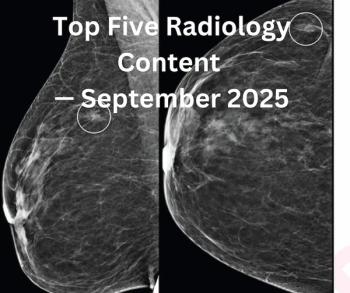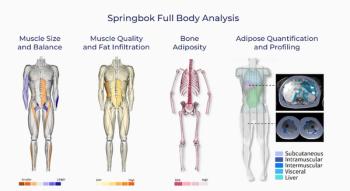
Radiologists may find higher level cardiac CT training useful
Because of the great potential of cardiac CT angiography for the future of cardiovascular disease diagnosis and management, many physicians have shown an interest in developing expertise in cardiac CT. A number of radiologists and cardiologists have received training in cardiac CT, and many more are planning to obtain such training.
Because of the great potential of cardiac CT angiography for the future of cardiovascular disease diagnosis and management, many physicians have shown an interest in developing expertise in cardiac CT. A number of radiologists and cardiologists have received training in cardiac CT, and many more are planning to obtain such training. Learning how to perform and interpret these examinations takes time and a focused approach.
The American College of Radiology and the American College of Cardiology have each developed competency guidelines, but their requirements have significant differences. Some key skills must be developed to become proficient in cardiac CT, and training to the more rigorous standards may be beneficial.
It goes without saying that radiologists and cardiologists are trained differently and have different skill sets and core competencies. Radiologists have much more experience with CT scanning and interpretation of images and with workstations, radiation safety, and contrast administration in the CT setting. Because of this base of knowledge, radiologists need to review only 50 cardiac CT cases to be considered competent in cardiac CT, according to the ACR guidelines.
Cardiologists, on the other hand, have usually had little exposure to CT scanning, CT physics, imaging workstation use, or imaging protocols. The ACC guidelines for level 2 competency therefore require 150 mentored cases, of which 50 must be live cases that the cardiologist witnesses.
Cardiologists do have extensive experience with cardiac and coronary anatomy, as well as with the evaluation and management of cardiovascular disease, and they know how to use different imaging modalities to best diagnose and then treat the patient. They understand the clinical implications of cardiac imaging modalities and how cardiac CT should be integrated into evaluation and management.
NEW SKILLS AND KNOWLEDGE
As an interventional cardiologist who trains both radiologists and cardiologists in cardiac CT and has extensive experience in this area, I hope to encourage debate about higher standards in training and higher levels of expertise in cardiac CT. Physicians undergoing training in cardiac CT must master several major skill sets. Didactic knowledge is essential, including CT physics, image formation and quality, patient safety, and contrast administration. Mastery of the 3D workstation includes "buttonology" in addition to manual skills associated with manipulating images in multiple planes. Cardiologists must become more comfortable working with 3D data sets and volumes of information rather than slices, while radiologists must become thoroughly familiar and comfortable with cardiac and coronary anatomy as well as cardiac pathophysiology. All need to know when and how this technology should be used and then what to do with the results.
That is a lot of new skills and knowledge to acquire, and doing so takes time, focus, a structured approach, and, most important, a large volume of cases. Exposure to a wide variety of pathology and practice on the workstation is essential.
My experience in training the average radiologist suggests that radiologists' detailed knowledge of cardiac and coronary anatomy is a bit rusty, as would be true of almost any physician other than a cardiologist. Obviously, if you have not been reviewing and interpreting cardiac studies for a while, you will not remember all of the coronary artery subtleties. It takes reviewing a volume of studies to remember this information and put it into clinical context.
Likewise, the average radiologist rarely knows all of the different manifestations of coronary atherosclerosis, and the massive amount of data can be overwhelming. A focused approach to pathophysiology, especially as it applies to cardiac CT, is essential, and again it takes seeing a large volume of cases to develop this expertise. Knowledge of bypass graft anatomy and disease is necessary, and congenital heart disease as well as noncoronary pathology of the heart need to be reviewed and integrated. Understanding the clinical indications for cardiac CT is also important. This is an area that is in flux, and many of the clinical outcomes trials are just now under way.
DIFFERENCES IN LEARNING
It is my experience that the average radiologist learns, understands, and develops a comfort level with the workstation more quickly than a cardiologist. Most radiologists have made or are making the transition to workstations and filmless environments. One skill set that very few radiologists have developed on the new generation of workstations, however, is multiplanar imaging.
We can now go beyond axial, sagittal, and coronal imaging to look at structures from virtually any angle and any plane, which is especially important in small tortuous structures such as the coronary arteries. It takes time and practice to get good at this multiplanar manipulation, however. Incorporating these new manual skills into a structured workflow system to navigate through the heart in a thorough fashion requires lots of practice.
Learning a structured workflow system is also essential to reading these studies in a time-efficient fashion. If one cannot read them quickly and thoroughly, then the business model does not make sense. We aim to get interpreting physicians' reading speed down to less than 10 minutes-closer to eight minutes-on the average case. This takes a significant amount of practice and volume. A structured approach is also important to make sure that nothing is missed, either under- or overcalled, as this can lead to potential liability.
Another reason to train to the higher volume guidelines is the need to meet hospital and insurance company credentialing requirements. Many hospitals have created or are in the process of creating credentialing guidelines for reading and performing cardiac CT. Although most are accepting the ACR guidelines for radiologists and the ACCF/AHA guidelines for cardiologists, there are exceptions.
Some hospitals are requiring all physicians who read and interpret the studies to be level 2 certified (ACCF/AHA). Several insurers are requiring level 2 training to read and interpret cardiac studies. CareCore, a precertification company that controls the imaging dollars for Oxford, Aetna, GHI, and others in the northeastern U.S., requires significantly more cases than the level 2 guidelines specify for physicians to be credentialed.
COMPETITIVE ADVANTAGE
Since the imaging marketplace is becoming more and more competitive, it is important to have an advantage. One way to obtain a such a competitive advantage is to be trained to the highest possible standards available. This can be important in the hospital as well as the outpatient environment.
Reviewing a significant volume of studies with a wide variety of pathologies is therefore extremely important to developing expertise. The question then is what constitutes the right volume. It depends on the individual and his or her level of comfort with all of the elements of cardiac CT imaging.
In general, we see most people start to feel mildly comfortable after 50 studies, mildly confident after 100, and very confident after 150. This process applies to both cardiologists and radiologists. It is interesting that 80% of the radiologists who sign up to do only 50 cases with us (level 1) end up continuing on to do all 150. Volume and experience with varying pathology builds confidence. We also observe a clear increase in reading speed from 50 to 100 to 150 cases.
The other thing that we have found is that mixed courses with both radiologists and cardiologists learning together are very beneficial to both groups. In a group environment, each specialty's strength as well as its weaknesses become clear to the other. Experience has taught us that, invariably, an environment of cooperation and sharing of knowledge ensues that adds to all participants' level of expertise. Interesting discussions about politics, turf battles, and how to create win-win situations occur in this mixed group setting.
Cardiac CT is a new skill set that has a steep learning curve and requires a great deal of hands-on experience to master. Whether you decide to train to ACR or to ACCF/AHA guidelines, the desired outcome is to obtain the highest possible level of expertise to optimize patient management. This is an attainable goal as long as you carefully select a high-quality training program that offers hands-on workstation training, an extensive cardiac CT library with varied pathology, and an experienced and involved mentor. Ultimately, it is your comfort level and confidence that will determine your expertise, motivation, and involvement in cardiac CT.
Dr. DeFrance is medical director of the CVCTA Education Center in San Francisco and national director of CT workgroups for the Society of Cardiovascular CT.
Newsletter
Stay at the forefront of radiology with the Diagnostic Imaging newsletter, delivering the latest news, clinical insights, and imaging advancements for today’s radiologists.


























